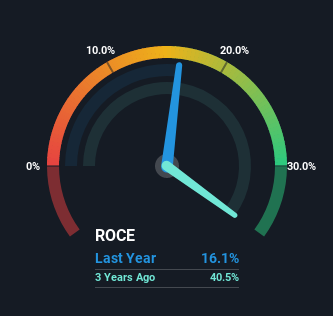- United States
- /
- Consumer Durables
- /
- OTCPK:TUPB.Q
Tupperware Brands (NYSE:TUP) Could Be Struggling To Allocate Capital

If you're looking at a mature business that's past the growth phase, what are some of the underlying trends that pop up? More often than not, we'll see a declining return on capital employed (ROCE) and a declining amount of capital employed. This combination can tell you that not only is the company investing less, it's earning less on what it does invest. So after glancing at the trends within Tupperware Brands (NYSE:TUP), we weren't too hopeful.
What Is Return On Capital Employed (ROCE)?
For those that aren't sure what ROCE is, it measures the amount of pre-tax profits a company can generate from the capital employed in its business. The formula for this calculation on Tupperware Brands is:
Return on Capital Employed = Earnings Before Interest and Tax (EBIT) ÷ (Total Assets - Current Liabilities)
0.16 = US$110m ÷ (US$1.1b - US$375m) (Based on the trailing twelve months to September 2022).
So, Tupperware Brands has an ROCE of 16%. That's a relatively normal return on capital, and it's around the 17% generated by the Consumer Durables industry.
View our latest analysis for Tupperware Brands

Above you can see how the current ROCE for Tupperware Brands compares to its prior returns on capital, but there's only so much you can tell from the past. If you'd like to see what analysts are forecasting going forward, you should check out our free report for Tupperware Brands.
So How Is Tupperware Brands' ROCE Trending?
The trend of returns that Tupperware Brands is generating are raising some concerns. The company used to generate 33% on its capital five years ago but it has since fallen noticeably. On top of that, the business is utilizing 37% less capital within its operations. The fact that both are shrinking is an indication that the business is going through some tough times. Typically businesses that exhibit these characteristics aren't the ones that tend to multiply over the long term, because statistically speaking, they've already gone through the growth phase of their life cycle.
What We Can Learn From Tupperware Brands' ROCE
In summary, it's unfortunate that Tupperware Brands is shrinking its capital base and also generating lower returns. This could explain why the stock has sunk a total of 92% in the last five years. That being the case, unless the underlying trends revert to a more positive trajectory, we'd consider looking elsewhere.
One more thing: We've identified 4 warning signs with Tupperware Brands (at least 2 which are significant) , and understanding these would certainly be useful.
While Tupperware Brands isn't earning the highest return, check out this free list of companies that are earning high returns on equity with solid balance sheets.
If you're looking to trade Tupperware Brands, open an account with the lowest-cost platform trusted by professionals, Interactive Brokers.
With clients in over 200 countries and territories, and access to 160 markets, IBKR lets you trade stocks, options, futures, forex, bonds and funds from a single integrated account.
Enjoy no hidden fees, no account minimums, and FX conversion rates as low as 0.03%, far better than what most brokers offer.
Sponsored ContentValuation is complex, but we're here to simplify it.
Discover if Tupperware Brands might be undervalued or overvalued with our detailed analysis, featuring fair value estimates, potential risks, dividends, insider trades, and its financial condition.
Access Free AnalysisHave feedback on this article? Concerned about the content? Get in touch with us directly. Alternatively, email editorial-team (at) simplywallst.com.
This article by Simply Wall St is general in nature. We provide commentary based on historical data and analyst forecasts only using an unbiased methodology and our articles are not intended to be financial advice. It does not constitute a recommendation to buy or sell any stock, and does not take account of your objectives, or your financial situation. We aim to bring you long-term focused analysis driven by fundamental data. Note that our analysis may not factor in the latest price-sensitive company announcements or qualitative material. Simply Wall St has no position in any stocks mentioned.
About OTCPK:TUPB.Q
Tupperware Brands
Operates as a consumer products company in the Asia Pacific, Europe, Africa, the Middle East, North America, and South America.
Low with weak fundamentals.
Similar Companies
Market Insights
Community Narratives



